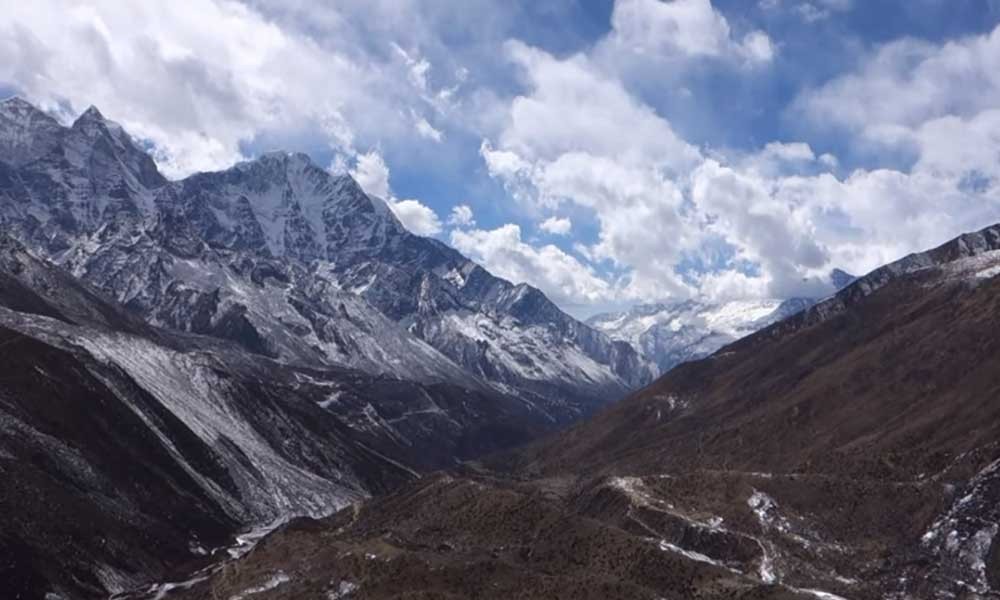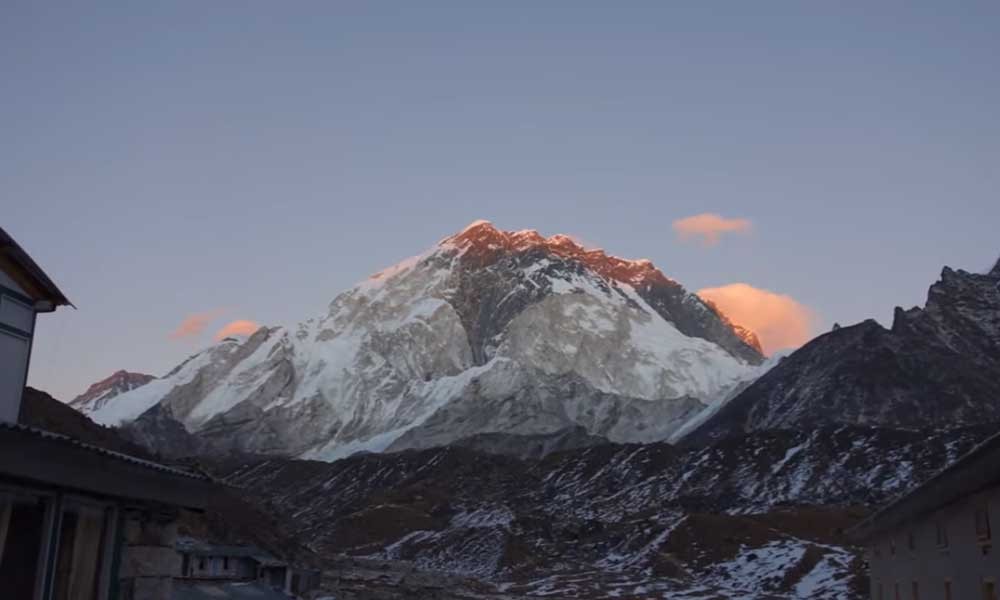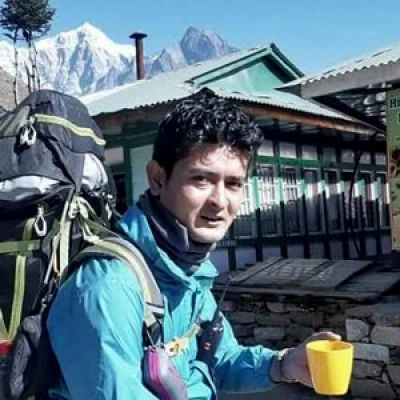Highlights of Everest Base Camp Trek in February
Panoramic view while flight to and from Lukla
To now Lukla has already become a center of interest for every trekker taking off Everest Base Camp. The flight that kicks off from Kathmandu and merely lasts 30 minutes, has more craze than any regular treks in the valley.
For that, applause goes to the mind-blowing scenery that can be easily noticed from the flight. In just half an hour, you get a full impression of what’s lying ahead on the journey.
Mountains that have dominated the scenic view of Lukla includes Mt. Everest and Nupla. Also, what you get to witness from your scenic flight is unique landscapes of the Himalayas and rich vegetation.
Incredible sighting from Kala Patthar
How is it even possible not to mention Kala Patthar when conversing about Everest Base Camp. The two are so entangled that no traveler can just pass by the rocky mountain without even exploring while on the way back from the campsite.
Just like Everest Base Camp, Kala Patthar too has plenteous natural wonder to offer its guests. One can discern the hypnotic view of Mt. Everest and Luptse from the ridge of the mountain.
The path to Kala Patthar reveals some finest scenery with beautiful landscapes and colorful valleys.
Exploring the rich culture of the Himalayas
 No one is unfamiliar with the fact that how rich Nepal is in terms of culture and history. And Everest region surely is a cultural enclave with different ethnic groups residing in the same locale.
No one is unfamiliar with the fact that how rich Nepal is in terms of culture and history. And Everest region surely is a cultural enclave with different ethnic groups residing in the same locale.
Despite the cultural difference, the locals here have maintained solidarity and integration which inspires every living human. People here have a sense of respect and admiration for every ethnic group and that’s what travelers are amused by.
Pay a visit to Tengboche Monastery
This has to be the best highlight of Everest Base Camp Trek and for every good reason. A much-renowned monastery of all in the entire Khumbu region, Tengboche is a masterpiece.
It is a great example of what Tibetan culture is and also a perfect way of how travelers can learn about their civilization. As the monasteries allow outsiders to partake in the festivals, one can have a close sight into the lifestyle of Buddhist.
For the trip to Tengboche Monastery, you’ll be escorted by your guide in the afternoon along with other visitors.
How is the weather of Everest Base Camp Trek in February?
February may once give a thought that the winter is finally on its way back. But, the climate at the base camp doesn’t seem to agree with it especially in the early days.
If you take a trip to the region in early February, you can expect the temperature to be around 8 Degree Celsius. But this is what the temperature at lower hills is like which causes the air to be moist.
As you ascend higher altitude, the weather is not pleasant at all specifically at the campsite and above. There is a probability that you may even face harsh weather with snow storms sneaking at times.
However, as the day passes the icy cold winter turns to a bright sunny day following warm weather. There is a relative humidity by late February which makes the trekking far more comfortable.
As spring is just days away from February, the weather starts to get lovely by its end. Flowers blossom throughout the valley and forest while animals awaken after drowsing all winter.
The air at the base camp too, loses its winter chills as the temperature gets warmer. The villages and trails once again smile as the spring makes its way in.
Temperature at the Everest Base Camp in February
 Although February may have had a bitter start, but the end is indeed astounding. The place that was earlier freezing cold with snow-covered begins to melt with the heat of spring.
Although February may have had a bitter start, but the end is indeed astounding. The place that was earlier freezing cold with snow-covered begins to melt with the heat of spring.
As the month prepares to progress to spring, the temperature soars up to 15 Degree Celsius in the day time. The nights and mornings are cold whatsoever with temperatures dropping to -10 Degree Celsius.
At the starting of February, the weather in and around the Everest region is impossibly cold. However, with every passing day, the month leaps towards spring weather causing the whole valley to lit.
Compared to what atmospheric condition winters are likely to have, February has a far better climate with a scenic view and clear sky. This month, the temperature is mild with fresh air coming right from the campsite.
How cold is it at the Everest Base Camp in February?
Everest Base Camp in February isn’t as icy cold as it is in December and January. The winter season is at its peak during the months so you can picture how chilly it is in the region.
Relative to that, weather in February sees less effect of winter with bright sunny days. Even the temperature is normal throughout except for the mornings and nights. Most trekkers seem to enjoy the climate along the way to Everest Base Camp since it showcases spring effect.
As the month comes to an end gradually, the snow starts to melt while birds return to their nestle. The trees and flowers once again come to life with the outgrowth of new green leaves.
Cost of Everest Base Camp Trek in February
The cost of your Everest Base Camp Trek in February relies almost entirely on how long you’re willing to stay in the region. It is based on which your accommodation, as well as foods and other amenities, are arranged. This is the reason why travel agencies request the trekkers to pre-book the trip so that they can plan ahead.
For your convenience, we too have provided you with the different itinerary so that it may help you decide the length of your stay. For the 12-days itinerary of Everest Base Camp, you’ll be charged no less than $1065.
The hotels and guest houses arranged under the package will provide you with many services including decent food and clean rooms with a bedsheet.
If you go with a 14-days Everest Base Camp Trek package, it will cost you a little more, to be specific $1440. In trade-off for that hefty cost, you’ll be offered standard accommodation with delicious meals and scenic views.
Cost Inclusions
- Pick and drop in a private jeep fro and to Tribhuvan International Airport
- Highly experienced guide with excellent skills in English
- Entry permit for Sagarmatha National Park and
- Internal flight to and from Lukla
- Personal trekking equipment such as knapsack and trekking poles
- Government tax and service fee
- Farewell dinner in Kathmandu
Cost Exclusions
- Tips for porters and guide
- Lunch and dinner during stay in Kathmandu
- Extra baggage charge
- International flight charge
- Fee for travel Insurance
Essentials and Preparation
 February marks the end of winter season and the beginning of spring. It is, therefore, the climate around the base camp and below is moderate with warm days. The sky remains clear throughout the day with just a few clouds looming later in the afternoon.
February marks the end of winter season and the beginning of spring. It is, therefore, the climate around the base camp and below is moderate with warm days. The sky remains clear throughout the day with just a few clouds looming later in the afternoon.
Meantime, there is stillness on the street and trail with fewer crowds traveling to the base camp. Following that, you won’t have a slight problem getting rooms even at higher altitudes.
Although trekking Everest Base Camp isn’t that tough, you need to prepare for it, both physically or mentally. You also need to have the right essentials in order to make it all the way to the base camp.
Physical Preparation
For anyone who has or hasn’t trekked earlier, physical preparation before Everest Base Camp trek is a must. You need to have better stamina to challenge an everyday hike of 6-7 hours. To boost physical strength, you can do regular workouts with cardio exercises and squats.
Mental Preparation
Even though Everest Base Camp Trek isn’t that tough, you still need to be mentally prepared. The climate at higher altitude can often worsen but there is no need for you to panic. Just be cautious and try to read the weather and you’ll be just fine. For the altitude acclimatization, we have lined up two days so that you can adjust to the environment.
Recommended Everest Base Camp Packing List
Trekking to Everest Base Camp is firmly unlike going on a regular hike. Even for a pro trekker, it can come as a huge challenge in the absence of the right backpack with right trekking gears. So here are some of the list of items that can help you conquer Everest Base Camp Trek in February.
Clothing
- Light fleece sweatshirt and pants
- Trekking trousers and shorts
- Lightweight Polyester shorts
- Waterproof jacket and pullovers
- Wide brim hiking hats and Beanie
- Light inner gloves and mittens
Footwear
- Comfortable hiking boots of high quality
- Lightweight trekking shoes and sandals
- Good brand trekking socks and gaiters
Other essentials
- Headlight and sunglasses
- Extra batteries, camera, and portable charger
- Personal toiletries and Medications with sunscreen and plasters
Itinerary
Day 01: Flight to Lukla, Trek to Phakding
Trek Duration: 30 minutes
Trek Distance: 136.17 km
Maximum Altitude: 2804 meters
Day 02: Trek to Namche Bazaar
Trek Duration: 5-6 hours
Trek Distance: 9.4 km
Maximum Altitude: 3450 meters
Day 03: Acclimatization at Namche Bazaar
Maximum Altitude: 3450 meters
Day 04: Trek to Tengboche
Trek Duration: 5-6 hours
Trek Distance: 9.5 km
Maximum Altitude: 3864 meters
Day 05: Trek to Dingboche
Trek Duration: 4-5 hours
Trek Distance: 9 km
Maximum Altitude: 4360 meters
Day 06: Acclimatization at Dingboche
Maximum Altitude: 4350 meters
Day 07: Trek to Lobuche
Trek Duration: 6-7 hours
Trek Distance: 10.7 km
Maximum Altitude: 4930 meters
Day 08: Trek to Everest Base Camp and back to Gorak Shep
Trek Duration: 7 hours
Trek Distance: 10 km
Maximum Altitude: 5364 meters
Day 09: Hike to Kala Patthar and trek back to Pheriche
Trek Duration: 5-6 hours
Trek Distance: 11 km
Maximum Altitude: 5550 meters
Day 10: Trek to Namche Bazaar
Trek Duration: 5-6 hours
Trek Distance: 14.3 km
Maximum Altitude: 3450 meters
Day 11: Trek to Lukla
Trek Duration: 17.7 km
Trek Distance: 6-7 hours
Maximum Altitude: 2810 meters
Day 12: Flight to Kathmandu
Trek Duration: 30 minutes
Trek Distance: 136.17 km
Maximum Altitude: 1400 meters
Similar articles you may like:
What difficulties does a trekker have to face during Everest Base Camp in February?
 Everest Base Camp Trek is already one of the most challenging hikes one can come around in Nepal. The trail here taking remote villages and rocky hills through gorges comes with ample difficulties and no comforts.
Everest Base Camp Trek is already one of the most challenging hikes one can come around in Nepal. The trail here taking remote villages and rocky hills through gorges comes with ample difficulties and no comforts.
But it’s the dazzling view of Everest alongside affable people that makes the trek so worth it. Along the path, Khumbu region possesses many beautiful monasteries and colorful villages that make the trip exciting.
But when you travel the region in February, there isn’t as much thrill as trekking in spring or autumn. That’s mainly because of the weather and climatic condition of the month which endures crisp weather.
Besides, there are also other challenges that are to be overcome by the hikers to reach all the way up to base camp. The list of some of the trek difficulties to deal with by people tripping to Everest Base Camp in February are:
Weather and Temperature
Weather and Temperature is certainly the major obstacle for hikers taking Everest Base Camp Trek in February. The cold climate of the month with icy wind put the endurance of travelers to test.
The temperature in the early days of February reaches below up to -16 Degree Celsius bringing heavy snowfall. But, as soon spring encroaches the region at the end of February, the weather becomes pleasant again.
It compensates for the frosty climate of early February by putting floral displays and green foliage along the way.
Altitude Sickness
Another difficulty that is likely to be put up by many trekkers on Everest Base Camp in February is altitude sickness. For those who are used to going on multi-day hikes may prevail over the sickness.
But the people who have no early experience of trekking often suffer from acute mountain sickness. While ascending higher altitude, they may face shortness of breath and even nausea and vomiting.
Hence to prevent the illness, it’s important that you improve your physical strength and stamina. Proper acclimatization to adapt to the environment also helps cope with sickness.
Experience Guide
February often sees fewer trekkers than that of March or September which are considered ideal times for trekking. Given that, the trails are usually stranded with only a few travelers tracking the route.
In such circumstances, it’s best for you to have a professional guide to assist. Only if you traveled solo in February, there remains an uncertainty whether you’d find help or not in case you got in trouble.
That’s because, in the month of February, there are fewer trekkers on the route. So, just to be on the safe side, make sure you have an experienced guide as a backup.
Similar trips you may like:
What to expect during everest base camp trek in February?
Expect a cold, snowy, and icy Everest Base Camp trek in February, offering fewer crowds, stunning clear-sky views of the Himalayas, but requiring proper gear like crampons for slippery trails, warm layers (nights drop to -15°C/-20°C), and patience for limited teahouse amenities, as it's peak winter, but the start of fewer people.
Weather & Conditions:
- Cold & Icy: Temperatures range from 0-8°C (day) to -15°C or colder (night/early morning), with significant wind chill at higher altitudes.
- Snow & Ice: Trails are covered in snow and ice, making stability challenging; crampons are essential for traction.
- Clear Skies: Often provides crystal-clear, unobstructed views of Everest and surrounding peaks.
- Longer Days: Daylight hours increase, giving ample time for trekking.
The Trek Experience:
- Fewer Crowds: Fewer trekkers mean a quieter, more intimate, and "true adventure" feel compared to peak seasons.
- Challenging Terrain: The snow and ice add difficulty, requiring more effort and proper equipment.
- Limited Amenities: Teahouses may have fewer services, and electricity/Wi-Fi can be scarce.
What to Pack & Prepare:
- Layered Clothing: Essential for temperature swings (base, mid-insulation, waterproof outer layers).
- Essential Gear: Waterproofs, warm hat, gloves, good sleeping bag, and crampons are non-negotiable.
- Physical Prep: Be ready for strenuous walking on slippery surfaces.

 No one is unfamiliar with the fact that how rich Nepal is in terms of culture and history. And
No one is unfamiliar with the fact that how rich Nepal is in terms of culture and history. And  Although February may have had a bitter start, but the end is indeed astounding. The place that was earlier freezing cold with snow-covered begins to melt with the heat of spring.
Although February may have had a bitter start, but the end is indeed astounding. The place that was earlier freezing cold with snow-covered begins to melt with the heat of spring. February marks the end of winter season and the beginning of spring. It is, therefore, the climate around the base camp and below is moderate with warm days. The sky remains clear throughout the day with just a few clouds looming later in the afternoon.
February marks the end of winter season and the beginning of spring. It is, therefore, the climate around the base camp and below is moderate with warm days. The sky remains clear throughout the day with just a few clouds looming later in the afternoon. Everest Base Camp Trek is already one of the most challenging hikes one can come around in Nepal. The trail here taking remote villages and rocky hills through gorges comes with ample difficulties and no comforts.
Everest Base Camp Trek is already one of the most challenging hikes one can come around in Nepal. The trail here taking remote villages and rocky hills through gorges comes with ample difficulties and no comforts.


